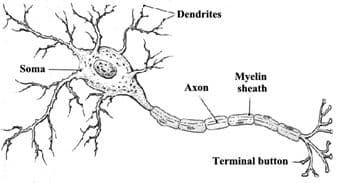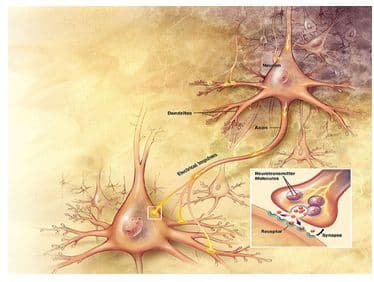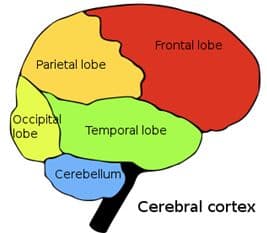Background Information
What makes a memory?
Memory is a process: "the creation of a persistent change in the brain by a transient stimulus." 6 In other words, a change happens in the brain because of some stimulus. How does it relate to learning? Learning is "acquiring new knowledge and skills", whereas; memory is to "retain knowledge and skills for the future." 7 Memory is what makes you who you are. Without it, all background knowledge would cease and your past would be a vacuum: no prior history, no family memories, just a void. We draw upon memories to make daily decisions. Memories are the building blocks of our education. Facts are retained in memory, but also problem solving skills, thinking patterns, and ways to do things physically, like walk or skip. Memory is what we remember and how much we can or do remember. It is our capacity to remember.
As an introduction to this unit, in the first lesson, students will be asked to:
- Tell what they had for dinner last night (working)
- Tell what they had for dinner last Saturday night. (working)
- Tell what they had for dinner the Saturday before last. (probably forgotten)
- Describe their earliest memory?
- Describe what is their best memory?
- Tell what the scariest memory is that they can recall?
- Convey if they have ever had a sibling disagreed over a memory in the past?
- Hypothesize if memories are subject to change?
- Define memory.
- Compare memory to learning
The purpose of these exercises is for student to conclude that memory is selective. People remember some things, but not others. Important memories, with emotional significance, are more likely to be remembered. Also, memories are subject to change over time. Often, when my sister and I discuss a childhood event, we will differ over to whom it happened. Learning is what we know, memory is what we recall.
How does Memory work?
"The brain goes through physical and chemical changes each time it learns." 8 During the second week, we will discuss how memory works. The basic component of memory is the neuron (gray matter), a nerve cell which transmits electrical impulses, at speeds up to 260 mph, throughout the body. Neurons contain "encoded genetic information that controls cell and energy producing equipment." 9 Our three pound brain has approximately 100 billion neurons. Each neuron is unique. Some may be up to three feet long and/or may last a lifetime. The components of a neuron are the cell body, the dendrites, and the axon (Figure 1). The dendrites receive and collect information or stimulus from other cells.

Like most other cells, the neuron's cell body is composed mostly of cytoplasm, includes a nucleus, and is surrounded by a cell membrane. The cytoplasm, which is largely water, contains less sodium than outside the cell; and the cytoplasm contains more potassium than outside. Diffusion of these ions creates an electrical charge across the membrane. At rest, a positive electrical charge is found outside the cell membrane, whereas the inside of the cell has a negative charge. This is known as resting potential. When a stimulus, for example, light or pressure, hits a neuron, "the stimulus opens gate-like pores in the membrane, allowing positively charged particles to rush into the cell and the negatively charged particles rush out." 10 This rapid exchange caused by the movement of charge particles, leads to an electrical event called an action potential.
Action potential provides a mechanism for sending information from region to region of a cell. When the axon hillock (the junctional region between the axon and cell body) becomes sufficiently stimulated, it generates the first action potential carrying an electrical charge to the axon. The axon ends at the synapse which is the physical site of connection with another neuron. The synapse determines whether a message is sent. Scientist believes this is where memory, as well as learning, occurs. 11 Here, neurotransmitters are sent to another cell. The axon of one neuron sends messages to the dendrite of another by the synaptic connection (Figure 2).

Figure 2: Illustrates how neurons are connected. The inset diagram shows the release of neurotransmitters in the synaptic connection, which is how messages are sent.
The senses receive information. Senses take in information, and electrochemical circuits form between neurons. These connections result in stored memories. Each day billions of pieces of information enter students' heads through the various senses. After being filtered, some of this information is lost and others are sent to different parts of the brain for processing. "What we call memory is the process by which the brain retains learned experiences over time through these physical, hardwired synapse connections." 12
Where is memory located?
Scientists now know that memory is not found in any one location. Higher level memory is found throughout the brain in the neurons of the cerebral cortex. This area is responsible for higher level thinking and emotions. By using functional brain imaging, which is comprised of techniques such as single photon emission, computed tomography (SPECT), positron emission tomography (PET), and functional magnetic resonance imaging (fMRI), researchers can now observe which parts of the brain are being used for different tasks. 13 The brain "breaks down a memory into informational components and routes each type of information to the area of the brain that is specialized for processing it." 14 This is why retrieval varies among individuals. Information is stored differently, and cataloged according to past experiences.
Before this imaging technology, scientists gathered information about memory by experiments and from their patients. In 1953, for example, an epileptic patient had his hippocampus removed in an effort to stop seizures. After the operation, he could not form any new memories, but could remember the past. A patient in 2001 had a viral infection that destroyed the hippocampus. The patient could not make new memories, but knew hometown classmates, and the way around town. These two patients made it clear that the hippocampus is responsible for creation of new memories.
For the third week of our study, students will learn about where in the brain memory is located. The cerebral cortex, the outermost layer of the brain is divided into two hemispheres. Each hemisphere has four lobes: frontal, occipital, parietal, and temporal. The exterior of the brain will be examined first (Figure 3). The frontal lobes are responsible for thinking and working memory. The temporal lobes process sounds, speech, and long- term memories like words, symbols, and stories. The occipital lobe processes seeing, or vision. The parietal lobe deals with recognition, calculations, and orientation, as well as working memory. The cerebellum, which is about the size of a lemon, is responsible for motor skills, procedural memory, and reflexive and conditioned responses.

The more interior regions of the brain include the brain stem and the limbic system. The brain stem is the size of a pinky finger and deals with functions basic to life, such as breathing and rate of heartbeat. Above the brain stem is the limbic system, which is comprised of the thalamus, the horseshoe shaped hippocampus, and the amygdala. The thalamus processes incoming sensory information. The hippocampus consolidates learning and is responsible for working and episodic memory. The amygdala processes emotion or fear. The focus of this part of our study is for the students to appreciate that different brain regions are involved in different functions and that memories are not located in any one area.
Although it appears to be straightforward where memory is located, this is not necessarily the case. Before modern technology was available, in a 1920 study, a scientist experimented to determine where memory was located. He removed different brain parts from rats. He assumed that when the correct part was removed the rat would no longer be able to navigate the maze. After systematically removing the different parts of the brain thought to be associated with memory, each rat was still able to do the task. This study proved that memory is not isolated in any one location.
How, if certain areas affect memory, can this happen? The answer is plasticity. Plasticity is the process of how our brains adapt to new situations. By brain mapping, scientist can locate different areas of the brain that control different parts of the body. In plasticity, the neurological assignments of the brain can change to enable parts identified to control one task to control another. MRI and other imaging techniques have been used to map the brain. Some people were found to have brain areas that were more developed than usual, and this correlated with their jobs, interest or disabilities. A New York cab driver had great spatial orientation, in order to find his way around town, so that part of his brain was well-developed. A violinist has a developed brain area that allows for small muscle coordination and finger movement. "The capacity of the brain to change with learning is plasticity." 1 5 By brain mapping, scientists can locate different areas of the brain that control different parts of the body. When plasticity occurs the neurological assignments for learning can change to other areas of the brain. Plasticity helps explain how stroke victims can learn and function even with certain areas of their brain are permanently impaired.
Memory Pathways
There are two kinds of memory: declarative (explicit) and nondeclarative (implicit). Declarative is the "conscious recall of facts and events". 16 It may be short-term or long-term memory. Declarative memory takes time to develop. For this reason, people usually do not remember events before the age of three. 1 7 Declarative memory is subjected to age and disease. It stores facts in the hippocampus and the cortex. Two components of declarative memory are semantic, which comprises of learned facts, and episodic, which refers to episodes or story experiences from life. Semantic memory deals with facts, such as names, where you keep your keys, and who wrote the Gettysburg's address. One does not often recall when or how the fact was learned, and the facts or events may be forgotten. "Our semantic retrieval process is affected by 'when' as much as by 'what' is learned. Studies indicate small efficiency increases when we recall details and text learned in the morning and relationships in the afternoon." 18 Episodic memory refers to a certain episode in your life. One's first date, or what was done yesterday. It contains one or more of the following: who, what, when, where, and how an event was experienced.
Nondeclarative or implicit memory deals with skills, habits, and reactions to conscious thought. 1 9 It may be procedural, conditioning, or priming. Procedural refers to learned skills and habits, such as how to do something, like swimming. Scientists believe this type of memory it is not affected by age because these memories are stored in several areas of the brain, not just the hippocampus, which can suffer with age. Another type of implicit memory, conditioning, is what one is trained to do, like waking up the same time each day or being hungry when the clock reads noon, lunchtime. It is learned information that triggers an automatic response. Priming, the third type of implicit memory, is the ability to recognize more quickly, a stimulus that has been previously presently. Multiple choice tests are popular among teachers and students. Priming is one reason for this; it allows the student to recognize what has been previously presented.
Types of Memory
Memory are either short-term, including immediate and working, or long-term. Immediate memory lasts from 5-20 seconds. An example is remembering a phone number for the short time it takes to dial. After this period, it is either sent to working or is discarded. Working memory lasts from a few hours to several days. When a student memorizes facts for a test, they are employing working memory. Both of these types of memory are limited: only so much can be remembered. When facts or events are reviewed, they may become long-term memory. When someone describes past events, or who they are, they are sharing long-term memories. These memories have an unlimited capacity. A long-term memory is one that is contained in strong synapse connections. Both types of memory, short-term, including working, and long-term decrease with age from the 20's until the 80's. The only thing that improves is verbal knowledge. 20 "The process of forming a memory changes the way existing neurons connect and communicate with each other. Short term memory involves temporary changes in neurons' electrical activity and the chemicals they exchange through their synapses". 21 Animal studies suggest that when one forgets, "weakening of the synapses between cells" may be responsible. 22 Short term memory involves temporary changes in neurons' electrical activity and the chemicals they exchange through their synapse.
For a long-term memory to form, these two changes MUST HAPPEN:
- Nerve cells extend their axons, allowing for more connections to other cells.
- Cells increase the release of neurotransmitters through the synapses, increasing "the power of each connection". 23
Through these changes, memory is made. The more memories, the more connections are made, hence the term of the brain being wired or in the case of plasticity, rewired.
During REM sleep, studies have shown that short-term memories can become long-term. The phrase "sleep on it" actually HAS VALIDITY.
Stages of Memory
There are three stages of memory: Receive, Review and Retrieve. Information is received through our senses in the thalamus, which is part of the limbic system. The hippocampus then consolidates this information. The second stage is review, which is when a memory enters working memory. It connects new information to past experiences. In this stage, techniques such as elaboration, summarizing, or think, pair, share must be used. If not, the memory will be forgotten. The third stage is retrieve, which is when information is remembered. Retrieval is the process of bringing long-term memory back to working memory. An analogy for this is when a sled goes downhill. The more time it goes in the same path or the more times a memory has been reviewed, the deeper the rut in the snow; in this case, the rut corresponds to a long-term memory. If a memory is not used, even long-term memories can be forgotten.
The types and stages of memory will be the topic for the fourth week of this unit. As an application for the stages, students will develop a board game under the pretense of being recruited for military service. "Receive" will be when a recruit goes through processing and basic training. "Review" will be when one gets their orders to go wherever. "Retrieve" is when they are sent back home or to another station. By designing and playing this game, students will reinforce the stages and the type of memory being used.
Future Implications
Although much has been learned using experimentation and technology about how memory works in the brain, there are still many unanswered questions. What will be the answers for amnesia, or Alzheimer's? Scientists have already been working on a drug that enhances memory. Cortex Pharmaceuticals is experimenting with "a class of molecules, known as ampakines, which facilitates the transmission of the neurotransmitter glutamate. Glutamate is one of the primary excitatory chemicals passed across the synapse between neurons." 24 By facilitating the action of this neurotransmitter, it is hoped a way to increase the brains ability to make and retrieve memories will be found.
Students will be asked to predict the future: how will new research findings on memory change the way they live. I personally want to see memory implants, and memory pills, so I can just take a pill to promote recall, or have knowledge put in my head. Not only could facts be implanted but also skills, such as how to fly a plane. I could have a GPS system implanted in my head, so I could remember where places were and not get lost. My students will pretend to be research scientists and write about their latest discovery and what implementation these discoveries will make. Through these predictions, I hope to let their creativity and imagination run wild and, just perhaps, plant a seed of interest as future scientist.

Comments: